One of the Marketing and PR industries’ best conferences on thought leadership and best practices occurs every year in June somewhere around the DC area. For the past two years we have called it Demand Success. Prior to that, it was known as the Vocus Marketing and PR Conference or the Vocus Users Conference. I know it well and have designed the event since it’s humble beginnings in 2004.
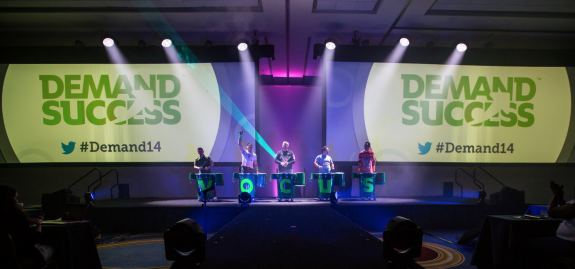
DemandSuccess Opening Act
Events are usually held at a big conference centers or, in our case, a conference space within a major hotel. Hotels present a specific type of challenge when it comes to branding the space. I don’t know who designs the carpets that cover these hotel floors but they aren’t what I would call neutral. So working around this can be difficult.
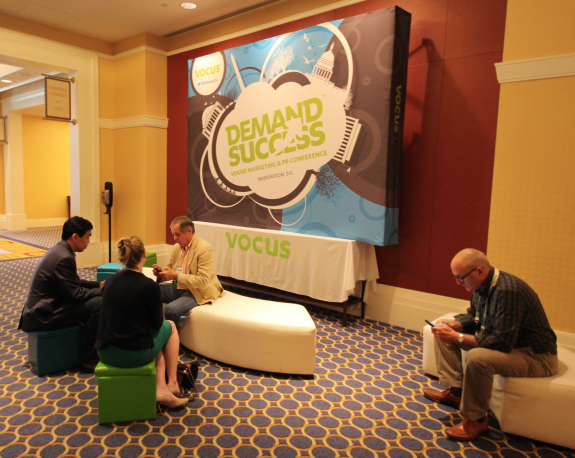
Create lounges for attendees to relax and brand the space with big murals and color matched ottomans.
The next challenge I usually face is trying to disguise or at least minimize the shades of gold, yellow and beige that hotels use on their walls and trim. I’m designing for a technology company in a highly creative and innovative marketing industry. Beige just doesn’t cut it.
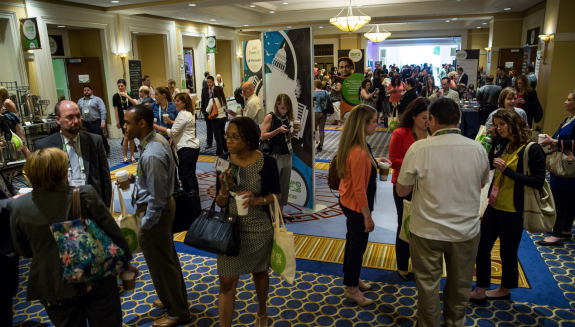
Designs are placed high against the walls and in the middle above attendees heads. Strategically placed boards promote flow and interaction with the brand.
Perhaps the most frustrating challenge is one I have experienced after designing many events at a multitude of locations. Nothing is ever proportional or square in these buildings. That is a rule you can live by. Even if the hotel sends you the specs for the counter top to be 32” tall by 109” wide by 23” deep. Don’t believe it because at some point that counter was broken or replaced or never installed correctly and your perfectly designed graphic, vinyl cling, banner or whatever just won’t fit when you arrive on-site. The door measurement from the top of the trim to the ceiling isn’t accurate either. In fact, it will vary from door to door in most cases.
Tip: Visit your venue as much as you can. Bring a measuring tape and a camera and take as many measurements, photos and notes as you can yourself.
There are plenty of other hurdles to overcome during this process. I will typically experience delayed responses from the venue or their inability to accurately answer my questions on what I can and cannot do to their conference hall. Not to mention my own internal budget approval hurdles.
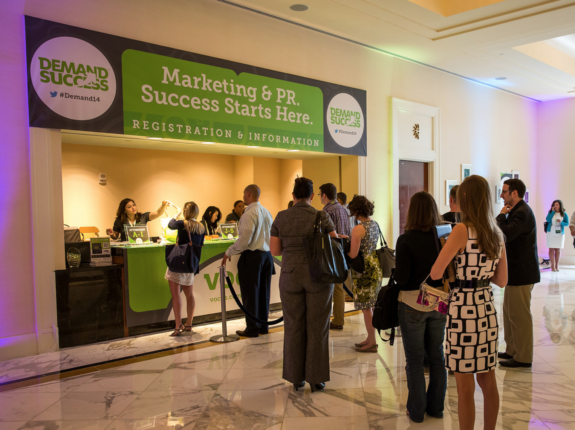
Large banner above the counter serves as a brand focal point. Matching countertop that drapes across the front disguises the hotel’s faux wood facade and further customizes the space.
When I was first tackling this project in 2004, I didn’t have a budget. I had to take the approach of showing the management team sketches that this is what we can do and here’s what this will cost to do it. I got about 10% of what I wanted the first time around. Today, I get a small budget which forces me to get highly creative with my approaches and make full use of my vendor relationships that I’ve developed over the years.
Tip: find a good print vendor who is smart, will work with you on ideas and ALWAYS delivers on time. Drop everyone else until you find this combination.
Next, use your internal teams wisely. Get ideas from them early and often. Get ideas from other events they have been to or things you have seen that inspired you. I start this process typically in late December which is about six months before the event. Then I’ll sketch, research, experiment and bounce the ideas off others. Many times we just won’t have the funds or corporate buy-in for the cool things and we probably only execute on 40% of what we ultimately want. That’s the reality but it doesn’t prevent me from asking for the $60k interactive floor every year.
My team has to complete their normal deliverables for our marketing and product initiatives before we can begin working on designs for the conference space. As a result, design conceptualization begins about two months out from the event date and accelerates towards a frenzy with just two weeks remaining. This can actually be fun if managed effectively. My costs are also coming in from vendors as we simultaneously work on concepts. Soon I’ll get a better understanding on what will ultimately make it to production.
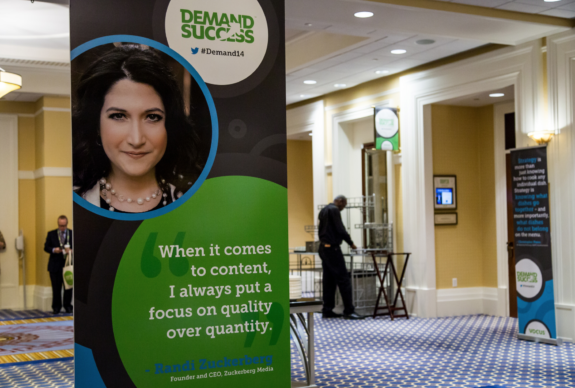
Show off your big keynote speakers with billboards throughout the space.
Before we jump in, I like to kick the project off by describing the vision to my team, illustrate the flow on the floor plan and discuss the expectations and challenges I’ve seen after several visits to the venue. I’ll then sit with my project manager and make a list of all deliverables. Finally, we move on to sketches, visual concepts, and a bunch of conversations on creative approaches.
Tip: Encourage your designers to step outside the box a little with their designs from the start. A good event needs movement, color and energy. If they push too far, you can always pull it back in. It’s harder to push later on in the process if it starts to feel too dry.
A few years ago I started what I now simply refer to as the wall. I like to see all the graphics at a glance and how they all work together. From the mouse pad for the workstations to the social media kiosks at registration and everything in between. When you move quickly and have multiple designers responsible for various portions of the event, it can easily go off course. So you have to be in control, in constant communication and have the complete picture in mind.
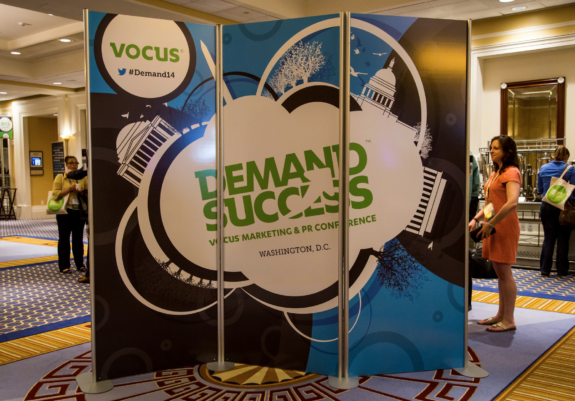
Promote attendee participation with graffiti murals. I was inspired do this after seeing a large whiteboard in the middle of a hall at another event. Of course a plain whiteboard isn’t interesting enough for me. I worked with my print vendor to get this display custom fabricated. It had to be free standing and support people writing and pressing against it.
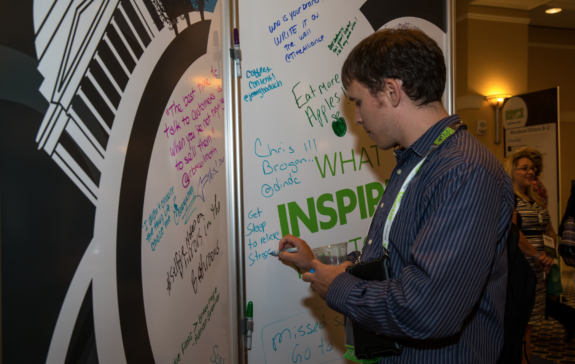
What inspired you today? That’s all we asked and both sides of this mural were filled with attendee quotes.
When a design is produced and has gone through a round or two of conceptual edits, it gets put on the wall. The designs on the wall are also for the other designers to see so they can work toward that visualization and maintain consistency. The wall is also there for me to course correct so I do not consider the designs on the wall as final just yet.
Tip: I do not consider each deliverable as its own project. Each piece is a small part of a larger project to be delivered at its conclusion. This allows me to make adjustments along the way.
The wall gets put up, ripped down, put up, organized and reorganized for about 5 weeks. When we complete all the printed deliverables, there is a good sense on what the event will look like, how it flows and what impression it will leave just by looking at the wall. The rest of the department has fun checking out our wall too. During this process, some consistent design element will usually stand out and I tend to incorporate that into the animated interstitials which have yet to be produced.
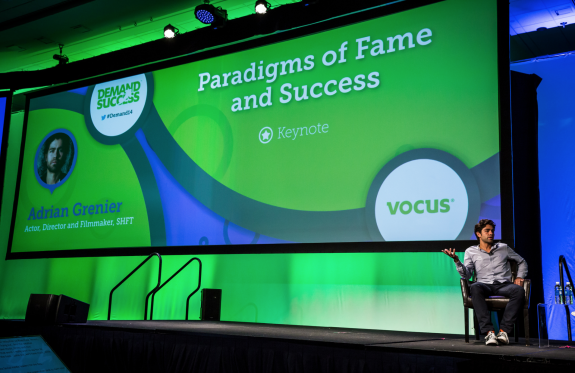
Large animated screens come together to form a nice backdrop for your speakers.
The session presentations are displayed on a large landscape of screens that fill the front of the rooms. There will be several projectors that make up one wide seamless screen and the presentations will live inside this design. The ideation for this actually occurs about three months prior with the powerpoint template, stage layout and installation renderings. Along with the presentations will be animations and videos that run between the sessions. All of this has to be designed and built during the final two weeks before the conference.
Two days before the event, my team and I arrive on-site. All my vendors have shipped the hardware and graphics directly to the event space so we start unpacking and assembling which continues through the night into the morning hours. We have fun with this process and are usually quite energized to see all our hard work taking shape in front of us.
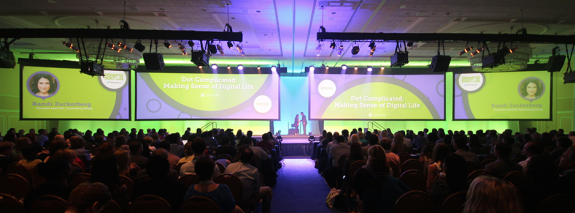
Animated screens roll in the speaker name and session title. Presentations fade in as part of the design and the outside screens become the imag.
The next day is filled with animated screen builds, stage lighting routines and run-throughs. I sit behind stage with one of my designers and the AV tech and we work together on the look and flow until 2AM. I’ll be back there again at 7:30AM to double check that we are good to go for our kickoff at 9AM. Soon after, I’ll grab a cup of coffee and my camera, meet with my event manager and start monitoring the conference to make sure everything is running smoothly for the next two days.
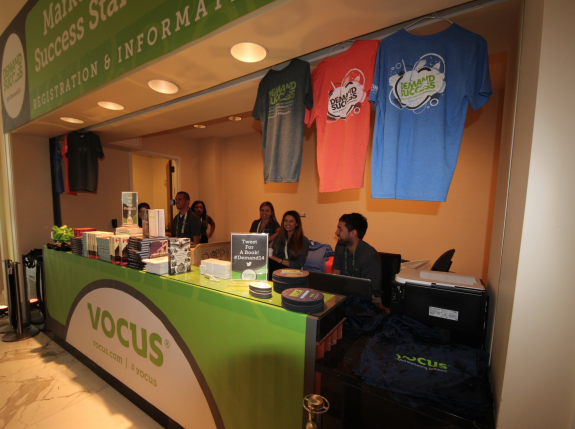
Design some fun swag and give it away for free.
Finally, you have to give a big congratulations to the teams that made it all happen. A talented team of designers, a thorough project manager, an energetic and organized event manager and all those content folks who proofed your work over and over again.
That is how Demand Success is designed.